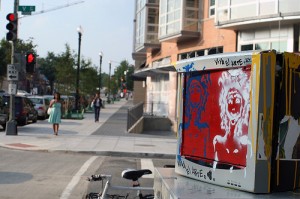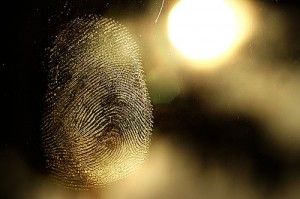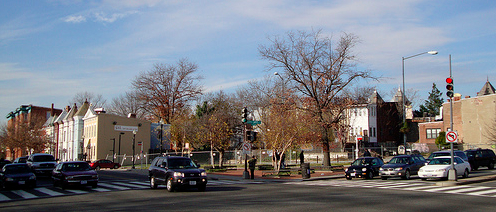Shots were fired at a busy intersection near U Street today. Two men were wounded in a drive-by shooting; neither had life-threatening injuries, according to Council member Jim Graham. A woman told NBC that a stray bullet hit the window of her apartment above Busboys and Poets while she was home having lunch. A conversation about whether the shooting would have gotten as much coverage had it been in a poor neighborhood ensued on Twitter.
Crime
RECENT POSTS
Race, Class and Lululemon
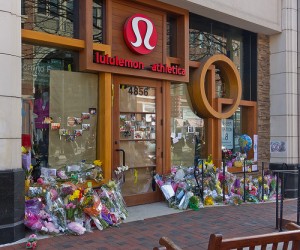
Flickr: ehpien
Pictures, flowers and stuffed animals surround the entrance to the Bethesda outpost of Lululemon, after Jayna Murray's murder.
Over at The Root, Latoya Peterson explores the race and class angles of the Lululemon case, which was initially thought to be a double rape and murder. Jayna Murray and Brittany Norwood returned to the upscale yoga store in Bethesda after hours; when a coworker showed up to open the store the next day, Murray was dead and Norwood was bound.
Norwood told police that two men had raped both her and Murray and then killed her coworker. That story unraveled as police investigated the case. Now, Norwood, who is black, is accused of killing Murray, who was white over a dispute involving potentially stolen merchandise. There was no sexual assault. Here’s Peterson on the media coverage:
Interestingly, though, both class and race had an indirect hand in why this story made national headlines. Slate touches on this: “The media does its part, of course. Murders don’t typically make headline news, unless there’s something unusual about them — for example, that they occur in an upper-middle-class suburb. (Slate’s Timothy Noah calls this genre of news coverage ‘When Bad Things Happen to White People.’)”
Spike in Youth Crime on Metro
Teens + Metro = Trouble? Many people assume that “equation” is true, and this story, One-Quarter Of Those Arrested On Metro Are Younger Than 20, from WAMU’s Kavitha Cardoza substantiates the link between young transit users and crime.
Metro Transit Police Chief Michael Taborn says there’s been a spike in crime committed by youth on Metrorail and Metrobuses; last year they made up a little more than 500 of the approximately 2,000 arrests.
And Taborn says many of the 90 assaults on bus operators involved youth.
When Taborn says “assault” he means that metrobus drivers have been on the receiving end of punches, flung objects or saliva. Taborn also confirms that the trend of recording altercations and uploading them to sites like YouTube inspires copycat crimes.
Here’s something I was unaware of, which explains a lot– as in, why a lot of students are using public transportation:
Taborn says over the past five years, more students attend schools that aren’t in their neighborhood, whether it’s to attend charter schools or because their neighborhood school has closed down. And that increases the opportunities for students to meet others from rival schools and crews.
Twenty thousand students use the Metro system every day.
I’ve only witnessed one incident where rowdy teens were confronted by a Metro employee, but it was memorable.
Should local police have to give fingerprints to the Feds?
You’ve heard of the DREAM Act, the bill that would offer a path to legal residency to great students that arrived in the US illegally when they were children. You’ve probably heard of SB 1070, Arizona’s law making it a state crime for non-citizens to be without their registration documents. But you might not have heard about Secure Communities, even though it’s a centerpiece of the Obama administration’s immigration policy, and it’s igniting plenty of controversy here in DC. And now more details are leaking out about how DC Police Chief Cathy Lanier has tried to work with the program. Continue reading
Three Surprising Facts About Metro Crime
Crime in the Metro system hit a 5-year high in 2010, according to a WMATA report released today. That’s the banner finding among many grim facts in the report, which you can read in its PowerPoint-y entirety here. Here are some of the other surprises:
A third of the 2,012 arrests in 2010 involved youths.
I’m not sure whether I expected this figure to be higher or lower, but it was definitely interesting. Many of our discussions of Metro crime over the past several months have been about youth on the Metro, such as today’s story embedded at right from MyFoxDC. Last summer’s brawl at Gallery Place sparked several comment threads about race and crime on various sites online, such as DCist. What do you think? Did you find this figure surprising?
4 of 7 sexual offenses “allegedly involved assaults on disabled customers by MetroAccess drivers.”
This statistic, from the WaPo story about the report, paints a very disturbing picture. An account from a WaPo story last April provides some more context:
Both contract drivers [charged with sexual assaults against customers] were hired after passing a background check, said Nikki Frenney, vice president of public affairs for MV Transportation, which oversees the 1,500 drivers in the MetroAccess system for Metro. MetroAccess provides about 7,700 trips a day for people with disabilities who are unable to use regular bus and rail service.
A homicide appears to be missing from the data.
MyFoxDC noted this in their story on the report. Indeed, the WMATA report claims no homicides occurred in the Metro system in 2010, but what happened to the homicide at the Congress Heights Metro Station in May? MyFoxDC asked Councilmember Tommy Wells, who didn’t have an answer for why the homicide might be omitted. The station wasn’t able to get a comment from Metro officials.
This Valentine’s Day, Mock Domestic Violence at a Museum! (Updated)
HollabackDC, a grassroots organization that is “invested in making the public spaces of the DC metro area safe for women and LGBTQ individuals” just tweeted something interesting:
That link takes you to a Change.org petition calling out a certain Penn Quarter museum for a hurtful holiday offering, which starts tomorrow:
The National Crime and Punishment Museum mocks the seriousness of intimate partner violence by romanticising such homicides as crimes of “passion.” The Valentine’s weekend exhibit “Crimes of Passion” makes light of a crime that affects thousands of Americans of all races, socioeconomic classes, ethnicities, gender identities, sexual orientations, and abilities.
Here’s how the Museum sells it:
…this Valentine’s Day, those darker romantics among us have a new way to show their love for their significant other, courtesy of the National Museum of Crime and Punishment. Back by popular demand, couples are invited this Valentine’s Day weekend to visit the museum and experience “Crimes of Passion.”
The City Paper’s Profile of Ali Ahmed Mohammed
Ali Ahmed Mohammed stopped existing on October 15. I use that odd phrasing because of something striking I have noticed– white people tend to say “he died”, while Black people use words like “he was killed”. Almost four months after a death which is still shrouded in mystery, the City Paper’s feature, “Something Happened at DC9. Who Did it Happen to?” doesn’t provide any additional information to those of us who wonder how Mohammed died or why.
So this is what the piece does do; it humanizes Mohammed while providing details about a man who has either been vilified or martyred, depending on whom you ask. This is what it does not do: assign blame. Maybe we’ll never know what happened, but if you are interested in one of the city’s most prominent immigrant communities, the article is worth a read:
One thing to know about Little Ethiopia: It’s not little. Decade-old census figures place the number of Ethiopians in the region at about 30,000, but community members suspect the real number is considerably higher—at least 100,000. It’s the largest Ethiopian community outside Ethiopia, says Andrew Laurence , president of the Ethiopian-American Cultural Center and the neighborhood’s unofficial historian.
Like the demographic that congregates there, Little Ethiopia has been growing. Today, Laurence says, it encompasses a “traditional border of 18th Street in Adams Morgan from Columbia Road to Florida Avenue over to 9th Street along Florida (U Street) to 9th Street and then down 9th Street to Q Street and over to 7th and Q Street.” Of course, Ethiopians aren’t the only ones who flock to the 1900 block of 9th Street NW. DC9, with its appeal to white hipsters, and Nellie’s, a gay sports bar on the corner, reflect two other populations with a growing presence in the neighborhood.
Laurence says D.C. became a hub for Ethiopian immigrants starting in the 1970s, “when Haile Selassie was overthrown.” The Marxist military regime that took over began killing off elites and intellectuals, Laurence says. Many fled to America, which had supported the deposed monarchy. The immigrant population was initially centered in Adams Morgan, near the former home of the Ethiopian embassy.
Gray, Lanier and Thomas Tour North Capitol After Murders
A little more information on the video I included in my morning roundup, for those of you who can’t access such things, via TBD:
D.C. Mayor Vince Gray, Councilman Harry ‘Tommy’ Thomas and police Chief Cathy Lanier toured the troubled North Capitol Street neighborhood that has seen two shootings in the past two weeks…The intersection of two busy thoroughfares has historically been a spot for day and night drinking, drugs, and crime.
The mayor and other city officials pledged more police and better lighting.
One of those two shooting victims, William Mitchell, was trying to help a woman he saw being attacked when he was shot. Mitchell had planted trees in and helped clean the park where he was killed.
Police have not identified a suspect in Mitchell’s murder and fliers seeking the killer’s identity are posted around the area. The city’s response to the murder of a white man has sparked controversy in what some describe as a gentrifying neighborhood.
According to Northeast resident Pari Parker, “They just doing that because he was white. If it was a black person they wouldn’t have done none of that. How many black people die around here every day?”
DCentric Conversation: Lisa LaFontaine of the Washington Humane Society

Washington Humane Society
WHS President Lisa LaFontaine and her lovely dog, Lila.
On Friday, I mentioned that I had interviewed Lisa LaFontaine, the President and CEO of the Washington Humane Society (WHS). We discussed several topics, most notably the stigmatization of Pit Bulls, which is a compelling and divisive issue. If I were a gambler, I’d wager that the reason why my “teaser” of a post was shared 20 times on Facebook (not typical for DCentric, no matter how many eyelashes or shooting stars I wish on) has more to do with America’s scariest dog than humane education or your kind support of my dream job writing for WAMU.
Lisa was so generous, she spent twice the allotted time speaking with me and for that I am grateful. Because we covered so much information, I’m splitting the interview in to two posts; part two will be up Wednesday morning.
Some of you may be wondering, what do dogs have to do with race and class; interestingly enough, this weekend and earlier today, whenever I was speaking with people involved with animals, their immediate response was, “Everything”. A colleague added, “Unfortunately, the stereotype is that the only people who own Pit Bulls are either white rednecks or Black drug dealers.” After speaking to Lisa LaFontaine, I know that such assumptions are inaccurate– and dangerous for a breed which was once affectionately referred to as a “Nanny dog”.
Continue reading
An Update on Latisha Frazier: Murdered, not Missing
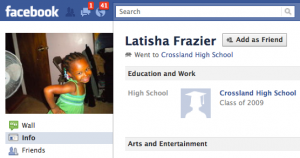
While Frazier's family searched for her, someone used Facebook to anonymously taunt and threaten them.
Last week, I included a story in my morning roundup about Latisha Frazier, a 19-year old woman who has been missing since August; Frazier’s family became worried when she disappeared, because the teen mother was devoted to her three-year old daughter, Diamond. A missing person is tragic enough, but Frazier’s family suffered even more when they were harassed with anonymous threats and taunts via Facebook. Once alerted to this unfortunate use of their site, Facebook removed the account and cooperated with MPD, which resulted in a breakthrough in the investigation; after seeing Frazier’s story on ABC7 news, someone contacted the MPD with information about the case, and yesterday, Frazier’s family learned that
“probable cause was established that on August 2, 2010, Latisha Frazier was at the 1700 block of Trenton Place SE, where she was assaulted during a dispute and was ultimately murdered.”
Brian Gaither, 23, of Southeast was arrested and has been charged with Murder Two and is scheduled to be arraigned Monday, police said.
At this time, Frazier’s remains have not been located.



